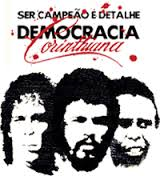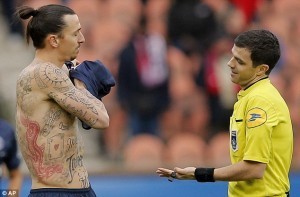Laurent Dubois's Blog, page 75
February 23, 2015
India: Back to its English roots
When I used to visit India quite frequently as a child, the focal point of the sports culture revolved around cricket. No matter what street you were on or what field you were playing at, cricket always established an entertainment culture to the population. India, though a dominant world player in cricket (winning multiple world championships), continues to develop its youth and adult soccer leagues in order to strengthen the market for entertainment. Being ranked 171st in the world, India turns to one of its former national coaches, Englishman Stephen Constatine, in order to turn its program, culture, and market into a huge world factor.
Stephen Constantine was a former English soccer player who played in the United States and played until the age of 26 and was forced to give up playing the game due to a knee injury. Constantine started his national coaching career in Nepal and eventually coached the India National team from 2002-2005. However, India did not have too much success on both the national and international scenes. Thus, the new Indian super-league was created to draw in players such as Alessandro de Piero from Italy. Record-setting attendances followed the creation of the 8-team super league, as hope for a developing soccer market continues in the eyes of many Indians.
On March 12th, India faces Nepal (ranked 180th in the world) in a huge game for the 2018 World Cup qualifying. Constantine continues to provide a newfound hope as he states that he has kept an eye on the India national team since his first go with the squad. He aims to improve medical care for the players as well as putting them in intense training conditions, much to the like of the British. He continously argues that India is not nearly in the position they need to be; however, with a cooperative effort between players, coaches, and all other members of the organization, India can get on the international map. Given the long history between England and India, it may be ironic that India turns to an English coach, but in a time where soccer continues to emerge in the entertainment industry, and with India’s developing economy under new leadership, it makes sense that now is the perfect time for India to establish itself in the international realm amongst the great soccer powerhouses. With Constantine’s good reputation in the coaching spectrum, I only see a positive step forward for this team, going in to the March 12th game with Nepal. Though India may not qualify for the next world cup…or two… I see a transitional period with more money being poured in to the soccer system in India. Now, when I return to India, I expect to see more soccer fields, more youth academy programs, and maybe, just maybe cricket may slowly be overshadowed by the emergence of soccer in India.

Constantine with the India National Team as they prepare for their qualifying match against Nepal
February 22, 2015
MLS Salaries
On my way home from a game of pickup soccer I was talking to a friend about what it takes to be a professional. We discussed the ultra tracked life of European soccer players, elite soccer academies, and reserve teams. However we also discussed the options for American soccer players, especially those who elected to go through college before making a move to the MLS. After this discussion I thought about professional soccer in America and how much these players get paid.
One of the first things that I noticed after starting to research these questions was that being a professional athlete does necessarily ensure fame and fortune. High salaries come to people, or sports that are popular, without popularity its hard to raise money through fans or sponsorships. In the MLS the average salary in 2014 for an MLS player is $80,000, a far cry from many other professional sports teams in the United States, and an income that is not terribly far off from that of a college graduate. There are also players such as Clint Dempsey, who, according to ESPN “will make $6.695 million this season – more than the TOTAL payrolls of 15 out of 19 MLS teams.” However Dempsey is a star, the highest paid player in the MLS, and most notably an exception. Even so, Dempsey’s salary is dwarfed by those of other American athletes such as Cliff Lee (Baseball) who earns $25 million per year, and Kobe Bryant who earns $23 million per year.
 As a rookie, most players come in earning the minimum salary of $35,125, a rather slim paycheck for anyone, and generally have to supplement their income with a day job that they can work around their soccer schedule. As soccer picks up in popularity in the United States salaries will surely rise, but for now, the salary of a typical MLS player is not as grand as one may think.
As a rookie, most players come in earning the minimum salary of $35,125, a rather slim paycheck for anyone, and generally have to supplement their income with a day job that they can work around their soccer schedule. As soccer picks up in popularity in the United States salaries will surely rise, but for now, the salary of a typical MLS player is not as grand as one may think.
February 20, 2015
Catar 2022 en contraste con Estados Unidos 2022
Mucho se ha dicho de la decisión de la FIFA de dar la sede del Mundial 2022 a Catar, un pais con pésimo record de derechos humanos, un clima que no es favorable para una competencia profesional, y una candidatura de muy alto riesgo dado que en este momento casi nada de la infraestructura necesaria para recibir el mundial está construída. La homofobia, las pésimas condiciones de trabajo bajo las cuales se construiría esta infraestructura, y el hecho que las ventas de alcohol – algo que la FIFA ya tiene una reputación de exigir de las sedes mundialistas – son ilegales – lo cual indicaría que no hay una manera efectiva para distribuir este bien- son solo algunas de las razones por las que la FIFA ha recibido muchas críticas por elegir a Catar para recibir la copa en el 2022. Esta decisión parece aun más cuestionable dada la competencia por esta sede. En la votación final, Catar se adjudicó la copa tras recibir 14 de los 22 votos disponíbles, contra los 8 que consiguió la candidatura Estadounidense.
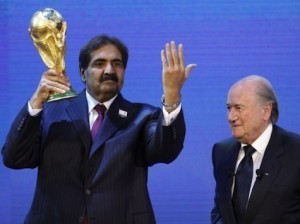
El director de la candidatura de Catar recibiendo la copa, junto a el Presidente de la FIFA, Sepp Blatter.
Este tema ya es bien conocido, pero lo voy a revisitar porque hace un par de días aparecieron reportes que dicen que el mundial del 2022 ocurrirá en Invierno, obligando al resto del mundo futbolístico a ajustar su calendario ese año y agregando una razón más por la que tener el mundial en Catar es una mala idea. Esto porque el calor del Verano de Catar llega a los 50 grados Celsius (122 grados Fahrenheit) lo cual imposibilita recibir un torneo deportivo profesional. Para el contexto del lector ¨- cuando en el mundial de Brasil el calor llegó a los 44 grados Celsius, la FIFA tuvo que crear una regla especial, que permitía a los jugadores tomar agua por 4 minutos cada media hora de juego. Esto fue una obligación que el sistema judicial de Brasil forzó tras determinar el peligro de jugar un deporte profesional en tal calor. Este inconveniente cambio – de tener el mundial durante el Invierno del hemisfério Norte – no tiene precedentes.
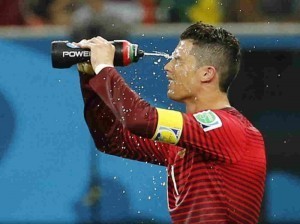
Durante el mundial de Brasil 2014, se implementaron tiempos muertos de 4 minutos donde los jugadores de ambos equipos tenían permitido tomar agua.
No obstante el clima, la falta de cultura futbolística en Catar también es algo a considerar. Al asignar el mundial de 1994 a Estados Unidos, la falta de cultura futbolística de ese país fué una de las más grandes críticas que recibió la FIFA. Pero esa indiferencia por el mundial de fútbol que fue vista en Estados Unidos en el 94 no se compara con la indiferencia de el público Catarí por el fútbol, y la falta de habilidad de su equipo nacional. De hecho, a menos que la selección Catarí clasifique al mundial de Rusia 2018, el 2022 sería su primera participación. Mientras tanto, el fútbol en Estados Unidos lleva ya varios años integrándose. Los triunfos de los equipos femeninos y la popularidad del fútbol entre los jóvenes ha aumentado la importancia cultural del futbol en Estados Unidos a un nivel que simplemente no está presente en Catar.

Fanáticos de Estados Unidos alientan a su selección en el mundial de Brasil.
Otro problema puramente logístico de tener un mundial en Catar es el hecho que no tienen la infraestructura ya construída. De los 12 estadios presentados en la candidatura oficial de Catar, Y la razón por la que esto es problemático – además de que va a significar un gasto enorme e inecesario, es que también va a significar la muerte de miles de obreros. Hasta la fecha, ya han muerto más de 1200 obreros Nepalíes e Indios construyendo estos estadios. Y la macabra racha continúa.
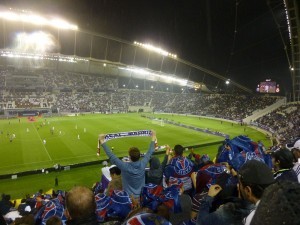
El estadio “Khalifa International,” el estadio con preparaciónes para recibir partidos de futbol más grande de Catar. Tiene una capacidad de 40000 personas.
Mientras tanto, al iniciar el proceso de crear la candidatura al mundial del 2022, Estados Unidos recibió cartas de interés de 58 franquisias deportivas, interesadas en recibir partidos mundialistas en sus estadios. 30 de estos eran estadios utilizados en la National Football League, y varios ya recibieron partidos mundialistas en 1994, cuando la copa vino a los Estados Unidos. Tras elegir los 12 estadios con las mejores instalaciones, la FIFA que los 12 estadios candidatos estaban listos para recibir el mundial, y no requerían más renovaciones.

El estadio Metlife, recibiendo el Super Bowl. El estadio tiene una capacidad de 82,500 fanáticos sentados.
Es más. De las 9 categorías utilizadas para evaluar el riesgo de la candidatura, Estados Unidos recibió una calificación de “mediano riesgo” en solo una (transporte terrestre, dadas las largas distancias entre ciudades candidatas a sedes como Nueva York, y Los Angeles) y “bajo riesgo” en todas las demás. En tanto, Catar recibió la calificación de “bajo riesgo” en solo una categoría, y recibió la calificación de “mediano riesgo” en todas las demás.
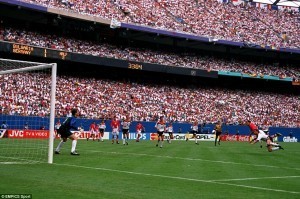
Alemania enfrenta a Bulgaria en el mundial de 94 en Estados Unidos.
Incluso visto desde el punto de vista puramente económico, tener el mundial en Estados Unidos sería la mejor manera de generar ganancias. La copa del 1994 tuvo un promedio de 68,000 espectadores por partido. La copa de Brasil del 2014 tuvo solamente 53,000. Incluso Alemania y Francia – dos países llenos de hinchas e instalaciones para practicar el fútbol – tuvieron menos de 53,000 espectadores en promedio. Claramente, Estados Unidos tiene un “track record” de demonstrar una habilidad enorme de generar ganancias.
February 19, 2015
Dr. Socrates – a Symbol of Corinthians’ Democracy
Branding a football player as a symbol of some sorts is perhaps as an overdone and exaggerated trait as the football fans in derby matches. After every good game players have, every move they make, even every comment they utter are followed by tens of labels; “legend”, “golden boy”, “judas”, along with thousands of insulting terms mixed with the players’ respective names. If such are the case, then perhaps Dr. Socrates doesn’t need another name to symbolize; he is Socrates, a symbol of democracy in Brazil, similar to how his Greek counterpart is regarded among many historians.
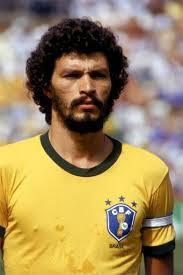
Socrates
Image from: news.uk.msn.com
To Socrates, the 15-year career he amassed means nothing to the democratic movement he led during his time in Corinthians. The Corinthians’ Democracy movement, or Democracia Corinthiana, was led by Socrates and his group of fellow footballers to introduce a democratic way of managing the club; they would often spend their nights, over bottles of alcohol and packet of cigarettes, discussing and voting subjects ranging from how the club should be managed to whether someone should go to the bathroom to take a piss. The movement served as a pressure to the military government to bring back direct presidential elections to Brazil, and as an encouraging message to the Brazilian people that their time of constraints by dictatorship is going to lift.
Banner of Corinthians Democracia.
The red splatter represents blood spilt to promote democracy
Image from: botecodosboleiros.com.br
Such drastic actions would surely have been stopped by the military government in any different setting; the fact that it was through football, the one setting that such actions could possibly be filtered down from an act of anarchy, undoubtedly played a big part in keeping the Corinthians’ Democracy movement going. Dr. Socrates himself showed to the world that, in situations as extreme as a military dictatorship, football can be served as a window to voice their opinion of justice; to him, that was the purpose of his football, as evident in his quote after Corinthians won the state championship in 1982:
“That was the greatest team I ever played in because it was more than sport. My political victories are more important than my victories as a professional player. A match finishes in 90 minutes, but life goes on.”
Purely from a professional footballer’s standards nowadays, Socrates would be labeled by many as a “wasted talent”, often indulging on cigarettes and alcohol throughout his entire career. Socrates himself admitted, in recalling his time in Florence, Italy, that he considered football second to his life, as a person and a thinker. What set him miles apart from such label, however, was his pursuit to bring democracy to Brazil in times of military dictatorship. He wasn’t what we would call a dedicated footballer; rather, he was a philosopher and a rebel, who used football as a tool to amplify his voice of opinion.
Feature Image from : Football Rebels, Al Jazeera
“The Doctor”
http://rompedas.blogspot.com/2010/02/...
Exibição do documentário “Ser Campeão É Detalhe”
February 18, 2015
Zlatan Saves the World, One Goal At A Time
The polarizing player for Paris Saint-Germain made a bold statement after scoring a goal less than 2 minutes into the game against Caen on Saturday. He removed his jersey, but rather than being in celebratory fashion, it was in the likes of charity. The action revealed the names of 50 starving people, that World Food Programme has worked with, temporarily tattooed on his body. The World Food Programme, who organized the event with Zlatan, put together this video to go along with the game:
The WFP director noted afterwards, “We thought of Zlatan Ibrahimovic, who is often asked for autographs. Why should it not be Zlatan, this time, who wore the autographs on his skin?”
Zlatan also added, “It’s the first time I have worked publicly with any charity. If we can reach the world’s leaders, I know that we can solve together the problem of hunger in the world.” In using soccer as a medium for communication, Zlatan has joined the cause to assist the United Nations organization in helping 805 million starving people around the world. He shares a powerful message with the use of a voice over in the video:
‘Wherever I go people recognize me, call my name, cheer for me.’
‘But there are names no one cares to remember. That no one cheers for: the 805m people suffering from hunger in the world today.
‘I have the supporters all over the world. From now on I want this support to go to the people who suffer from hunger, they are the real champions.
‘So whenever you hear my name, you will think of their names.’
25B4B70800000578-2954515-image-a-5_1424013439509.jpg
After removing his jersey, Zlatan was issued a yellow card, with the referee giving him a look of, “Come on, you know better.” Also unhappy about the move was manager, Laurent Blanc – seeming to be unaware of Zlatan’s plans, who emphasized his disapproval in Zlatan taking a yellow card only two minutes into the game and the risk that it carried for the next 88 minutes. PSG ended the game with only nine players on the field, Zlatan being one.
25B29C7400000578-2954515-image-a-7_1424013624736.jpg
Overshadowed by this widely talked about statement, was the fact that PSG gave away a 2 – 0 lead that they had built in the first half, allowing Caen to score twice with only minutes left in the game. The Paris side had to finish the game with only nine men on the field because of two injuries that came after the team had already made its allotted three substitutions. The game ended in a 2 -2 draw with PSG missing out on an opportunity to jump Lyon and Marseille and take first place on the Ligue 1 table.
Undoubtedly, most people will not remember this game as one that PSG let slip away, but as the one where we saw a new variety of Zlatan once again being Zlatan.
Game Highlights:
sources:
http://www.dailymail.co.uk/sport/foot...
http://www.espnfc.com/paris-saint-ger...
No Pierdas La Cabeza, Atlético
Últimamente Atlético Madrid se ha encontrado en el noticiero del mundo de futbol a menudo – desafortunadamente, las noticias que rodean el club no han sido positivas completamente. Como Diego Simeone y sus “Colchoneros” preparan para su próximo partido contra RCD Espanyol en el 4 del Marzo, el equipo está lidiando con un decepcionante empate contra el mismo equipo la ultima semana y una exhibición pobre de la deportividad en su pérdida a Barcelona a finales de enero. A lo largo del partido, el entrenador y los rojiblancos perdieron sus estribos y también sus botas.
Por supuesto, todos los aficionados en Vincente Calderón y el resto de los telespectadores vieron el incidente en que Arda Turan agresivamente tiró su chimpún a la juez de línea con intento para golpearla. Turan tuvo una racha de buena suerte cuando soló se estuvo castigado con una tarjeta amarilla. Aunque los árbitros reaccionó levemente, las redes sociales no estaban tantos simpáticos. Memes y vídeos incontables que se burlan de Turan inundaron inmediatamente después del incidente – uno que compara la acción del jugador con esa de la periodista que lanzó su zapato al presidente George W. Bush en 2008. Turan no se inmutó por la abundancia de la crítica, como lo demuestra por una fotografía en que el jugador aparece con una torta de cumpleaños en la forma de un chimpún.
El episodio de Arda Turan es bastante humorístico pero al mismo tiempo representa la descompostura de los estribos de los jugadores de Atlético. Antes del fin del partido, Fernando Torres también tiró su bota y el futbolista español Raúl García fue expulsado del juego por una falta grave contra Lionel Messi. En total, Atlético termina el partido con seis intrusiones y dos jugadores que ha estado quitado de la cancha.
Como si el mal comportamiento de su equipo no era vergonzoso lo suficiente, se rumorea que Diego Simeone, el entrenador de Atlético hizo un gesto desdeñoso a un arbitro y después de la conclusión del partido él amenazó uno de los jugadores barcelonés. Aunque los representantes de Atlético niegan estas acusaciones, es evidente que su pérdida contra Barcelona sacudió los nervios de Los Colchoneros. Si el equipo restante de Madrid quiere ganar la Copa del Rey, el club no podrá perder la cabeza en los ultimas semanas.
Fancred: Your Sports Identity
Fancred, an avant-garde, sports website and top 50 application for iPhone and Android, keeps fans up to date with their favorite sports and teams with a distinctly personal, social twist.
The website, nearing its third year of existence, functions both as a social network and a source of news. Users can track different sports, including soccer, and subscribe to specific team’s feeds; the experience is highly customizable. These feeds are occupied by content posted by users, such as news, photos, articles, videos, GIFs and simple grumblings related to certain sports and teams. Users follow each other based on similar interests. On your personal profile, your picture and all of your favorite teams are presented, along with a complete history of your activity. Fancred allows users to preserve their favorite sports moments. Their archived profile acts as a digital vault. As your general activity on the network increases, so does your score-a reflection of your “cred” as a fan.
Fancred borrows from both social and journalistic networks, creating its own hybrid one. Similar to Facebook, Fancred allows users to comment, like and share each other’s posts, which appear in various forms (photo, link, expression, etc.) Additionally, Fancred offers the dislike option on posts, spurring the competitive atmosphere sports fans crave. Banter between Barcelona and Madrid fans flourishes. The content is not solely user-generated, as journalists and organizations have joined Fancred. For example, the Atlantic Coast Conference (ACC) operates a Fancred account. Posts are generally filtered by use of tags, much like Twitter. Fancred is a GIF-friendly site, mirroring Buzzfeed and others’ obsession with the slow motion video repeats. The main, rather obvious, distinction between Fancred and other social media outlets is the way in which it specializes in sports. Instead of filtering through your Facebook, Instagram and Twitter for sports related-content, you can rely on Fancred.
Fancred satisfies an emerging interest in more specific, condensed, social media, and follows a developing trend.
“I think it is too early to say that they’re abandoning the larger social networks, but certainly the audience for those networks is now fragmented,” said Shayla Thiel-Stern, a professor of journalism at the University of Minnesota.
Thiel-Stern’s observation explains the popularity of applications such as Snapchat, Vine, Pinterest and WhatsApp. These apps contain their own, defined purpose, unlike the more inclusive Facebook and Twitter. The growing complaint with Facebook is the way in which it has become almost too public of a space. While soccer fans on Facebook scroll past countless pictures of their neighbors’ baby and late-night musings from their grandmothers, they can engage in conversations focused on their team and their sport on Fancred. According to CNN’s Paul Gross, 56% of teens from a 2014 study said that they were active on Facebook, compared to the 76% from the start of the year.
The communal atmosphere of Fancred allows fans to watch live events virtually together. Questions can be answered, excitement can be shared, and disdain can be voiced. With Fancred, the solo-watcher is not alone during the game.
Fancred is changing the way fans experience all sports, but in a more unique way with soccer. With soccer as the world’s most popular and widespread sport, fans from all over the globe interact on Fancred every day. While football fans from Texas and New York are given a chance to interact where there was little before, soccer fans from Munich and Rhode Island are given the same chance where there was even less of one. Fancred allows the global game to truly become global.
While many soccer-focused bloggers and journalists contribute to Fancred, Liverpool FC stands out as a noteworthy member. Last year, the club added Fancred to their official social media strategy. The club’s page is certified by the app as a legitimate, organization-run outlet.
On Fancred, socializing becomes even more a part of the sports experience. Founder and CEO Kash Razzaghi understands the way in which friendship and sports have always paired together.
”The way I integrated myself into the community was through sports,” he said. “I found my network of friends who cared about sports, and those people are still my lifelong friends.”
Razzaghi believes that one should not only follow sports, but unify around them. Users do not just digest news, they share and enjoy it. While Fancred informs, it simultaneously connects.
February 17, 2015
Happy belated Valentine’s Day!
I realize I’m four days late but I wanted to share this video with you anyway as it captures our (respectively English guys’) love for soccer pretty accurately. Enjoy!
The South American International Tournaments
The Copa Libertadores group stage kicks off this week, beginning what is regarded (at least by south Americans) as one of the most brutal professional tournaments in the world. Teams have to play in the heat of Salvador, Brazil, in the heights of La Paz and Cuzco, in the humidity of the Amazon, or they may have to make overnight trips to Mexico. Many world-famous players showed their worth for the first time in this tournament. Winning it is the highest glory to which South American teams aspire. But there’s another tournament in South American football that, despite being regarded as “worse” by many people, is still a very prestigious tournament. I’m talking about the Copa Sudamericana.
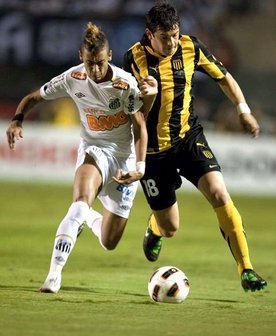
Santos, from Brazil, playing against Penarol, from Uruguay, in the 2011 Copa Libertadores Final. Santos went on to win 2-1 on aggregate.
In Europe, the Europa League and the Champions League are the two biggest tournaments, with the Champions League being the more prestigious one by far. In South America the situation is similar, but the two south american tournaments are not completely analogous to the European international tournaments. Aside from differences in funding, world reknown, sponsorship, and the undeniable fact that the European tournaments carry much more prestige than the South American ones, there are other, more fundamental differences.

San Lorenzo’s Romagnoli lifts the 2015 Copa Libertadores
The largest difference is the timing. In Europe, the tournaments span the entire season, with the champions league final being usually the last competitive professional match of the year before the off season. In the CONMEBOL, each of the two tournaments takes only half a season, much like most national tournaments are split in two parts – one before the mid season transfer window and one after. The last Copa Sudamericana spanned from August to December of 2014. The second leg of the final was played December 10th. River Plate, the winning team, played 8 games to win the cup, while the finalist, Atletico Nacional de Medellin, played 12.

Alianza Lima, of Peru, in the Copa Libertadores.
The reason why this first tournament is so short is because there is no group stage – it’s all knockout rounds. This tournament is widely regarded to be “inferior” to the Copa Libertadores, in part because of how short it is. It started officially in 2002 after several other tournaments – the Copa Mercosur and the Copa Conmebol most notably – were merged. Thus, it has a much shorter history than the Copa Libertadores, too. When a team wins the cup, fans of the rival team will likely tease, saying the tournament “doesn’t really count.” It is clear that, in the mind of most if not all south american soccer fans, the Copa Libertadores is the highest aspiration. But this cup matters, too.
The Copa Libertadores is still the most important, most prestigious, and most exciting tournament in South American club football. Only 22 teams have won it, and if you ask a fan of any of the other teams, they’ll say it is their dream to see their team lifting the trophy. It began in the 1960s and has gone from a small, 7 team tournament that spans little over two months, to a 36 team tournament that spans half a season. It has been the stage for many legendary players to show their worth, and lately, it has been a recruiting ground for the much richer European teams to get their players.
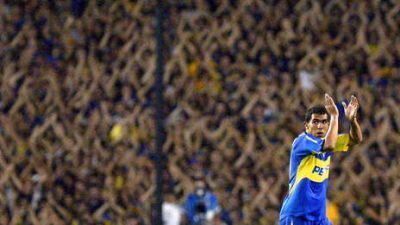
Carlos Tevez played in the Copa Libertadores for Boca Juniors (pictured) and Corinthians before moving to Europe.
The current Copa Libertadores began February 3rd and will end August 5th. By then, the two finalists will have played either 14 or 16 games, depending on whether or not they had to go through a qualifying playoff before entering the group stage. Teams will play every every week for the next 6 weeks to determine who gets out of the group stage. Then they will have a one week recess and from there, they will go back to playing every week until they are eliminated or they win the tournament. This stands in stark contrast with the Champions League, where teams play every two weeks, and there is a two month recess at the end of the group stage. Thus, winning each of those two tournaments has a merit of its own – in Europe, it’s the most skillful team that wins, but in South America, winning requires endurance as well. Teams that are lackluster technically have been known to defeat other teams because of differences in endurance.

A photo from the Copa Sudamericana semi-final match between Atletico Nacional of Colombia and Sao Paulo FC, of Brazil.
¿Fue legal el gol más rápido de la historia?
Vuk Bakic, delantero serbio del GSP Polet, anotó este gol en el saque inicial del partido que su equipo ganó 4-1 en septiembre de 2012. Fue, casi literalmente, como si su equipo comenzara el partido con el marcador a favor.
Ahora bien, el gol suscitó una gran polémica puesto que habría dos factores que no harían legal al que puede ser considerado como “el gol más rápido de la historia”.
En primer lugar, cada vez que un equipo reanuda el juego desde la media cancha “después de que un equipo marque un gol”, la pelota debe ser tocada hacia adelante al menos una vez por un jugador antes de que otro compañero (y no el primero en tocar la pelota) pueda disparar al arco, tal como lo señala las reglas de la FIFA, específicamente la “Regla 8 – El inicio y la reanudación del juego”.
Muchas personas en los foros de Internet han señalado que este gol no debió haber sido válido, ya que Bakic dispara al arco contrario sin que nadie tocase el balón antes que él. La regla de los dos toques (“el balón estará en juego en el momento en que sea pateado y se mueva hacia adelante”) es aplicable siempre que haya un gol previo, como se desprende de la lista de arriba. Sin embargo, la definición de “saque de salida” añade que, al comenzar un partido, un jugador puede patear al arco y anotar un gol. Y eso es lícito.
En tal sentido, el gol sería válido, puesto que no es un saque de salida tras un gol, en el que sí se necesitan al menos dos toques por dos jugadores para que el gol sea válido, sino un saque de salida inicial, en el que se puede disparar al arco directamente.
Pero, en realidad, tal como la regla lo señala, ningún jugador de un equipo puede estar en el campo contrario antes de la reanudación del juego en un saque de media cancha (saque inicial en cualquiera de las dos mitades del juego, tiempos suplementarios o tras un gol). Es claro que su compañero de equipo está invadiendo el lado contrario antes de que Bakic dispare, por lo que el extraordinario gol del GSP Polet no debió hacerse efectivo. Es por esta razón y no por la regla de dos toques que el gol más rápido de la historia no debió subir al marcador.
El entrenador del GSP Polet, Zoran Sredic, afirmó que no le sorprendió que Bakic intentase disparar al arco. “No es casualidad pues Vuk generalmente se queda después de cada entrenamiento para golpear el travesaño desde una variedad de ángulos,” dijo Sredic.
Por otra parte, el uruguayo Ricardo Olivera marcó un gol similar al de Bakic en un partido amateur en su país natal (diciembre 1998). El jugador del club Río Negro pateó la pelota directamente al arco en el saque inicial y el balón entró a la portería en 2.8 segundos. Desde 2004 éste sí es considerado como el gol más rápido de la historia del fútbol por el Record Guinness (aunque no he podido encontrar el record en su página web). No obstante, como señala este artículo, hay otros candidatos que disputan tal título.
Una anécdota triste con respecto a uno de estos candidatos. En 2009, el jugador de Arabia Saudita Nawaf Al Abed marcó un gol de saque inicial en dos segundos en la victoria de su equipo el Al Hilal contra el Al Shoalah en un campeonato Sub-23. Sin embargo, el Al Hilal alineó indebidamente a seis jugadores mayores de 23 años en el partido. Como consecuencia, se otorgó una victoria de 3-0 al Al Shoalah y el gol de Al Abed no entraría en los records oficiales.
Laurent Dubois's Blog
- Laurent Dubois's profile
- 44 followers


